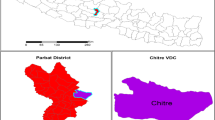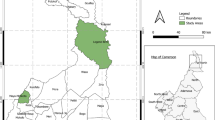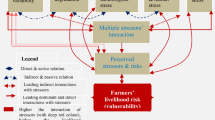Abstract
Vulnerability assessment is fundamental for informing adaptation to climate change policy. The aim of this study is to evaluate the vulnerability of rural subsistence farmers in Uganda to climate risk. A mixed methods approach used semi-structured and guided interviews, and participatory techniques to explore perception, livelihood response and socio-economic status. Perception of climate risk varied, with wealthier farmers perceiving drought as highest risk, whilst poorer farmers perceived extreme heavy rainfall. Farmers implemented many general livelihood coping and anticipatory responses (54.7 %) to perceived impacts from drought, rainfall variability and extreme heavy rainfall. Examples included food storage, livestock maintenance and planting drought-resistant varieties. Other responses (45.3 %) were specific to individual climatic events, and farmers had no response to cope with rainfall variability. Climate risk was not the only driver of vulnerability. Soil infertility, pests and diseases, and economic instability also sustained decreasing trends in income. Adaptive capacity of households differed with external and internal attributes of sensitivity. Farmers with more land, education, access to governmental extension, a non-farm livelihood, larger households and older age had more capacity to buffer shock through increased assets and entitlements than poorer farmers who were more likely to engage in opportunistic behaviour like casual labouring. Few livelihood responses associated with perceived threat from the climate indicating response to a broader range of stressors. Conclusions determined inequality in livelihood response as a fundamental driver in households’ ability to cope and adapt to climate risk.
Similar content being viewed by others

Notes
Proximity to a weather station was selected to benefit other related research. The sampling of study sites did not use location as a selection factor; however, location was used in the study to assist comparative analysis.
Accelerated ripening of bananas occurs due to increases in the production of ethylene: a plant hormone produced excessively when plants are under stress (Liu et al, 1999). Further climate stress palpably has serious implications for this region’s food staple.
Farmer interview: [SSI.23.MN.NY.Y, Nyanja, 16th February 2010].
Farmer interview: [SSI.113.FN.R, Rukindo, 27th April 2010].
References
Adato M, Carter MR, May J (2006) Exploring poverty traps and social exclusion in South Africa using qualitative and quantitative data. J Dev Stud 42(2):226–247. doi:10.1080/00220380500405345
Adger WN (2006) Vulnerability. Glob Environ Change 16:268–281. doi:10.1016/j.gloenvcha.2006.02.006
Adger N, Kelly PM (1999) Social vulnerability to climate change and the architecture of entitlements. Mitig Adapt Strat Glob Change 4:253–266. doi:10.1023/A:1009601904210
Adger WN, Paavola J, Huq S (2006) Towards justice in adaptation to climate change. In: Adger N, Paavola J, Huq S, Mace MJ (eds) Fairness in adaptation to climate change, 1 st edn. Massachusetts Institute of Technology, Cambridge MA
Adger WN, Agrawala S, Mirza C, Conde K, O’Brien K, Pulhin J, Pulwarty R, Smit B, Takahashi K (2007) Assessment of adaptation practices, options, constraints and capacity. In: Parry ML, Canziani OF, Palutifkof P, van der Linden PJ, Hanson CE, Climate change 2007: impacts, adaptation and vulnerability. Contribution of working group II to the fourth assessment report of the intergovernmental panel on climate change, Cambridge
Adger WN, Dessai S, Goulden M, Hulme M, Lorenzoni I, Nelson DR, Naess LO, Wolf J, Wreford A (2009) Are there social limits to adaptation to climate change? Clim Change 93:335–354. doi:10.1007/s10584-008-9520-z
Adger WN, Barnett J, Brown K, Marshall N, O’Brien K (2013) Cultural dimensions of climate change impacts and adaptation. Nature Clim Change 3(2):112–117. doi:10.1038/NCLIMATE1666
Alpizar F, Carlsson F, Naranjo MA (2011) The effect of ambiguous risk, and coordination on farmers’ adaptation to climate change—A framed field experiment. Ecol Econ 70:2317–2326. doi:10.1016/j.ecolecon.2011.07.004
Antwi-Agyei P, Stringer LC, Dougill AJ (2014) Livelihood adaptations to climate variability: insights from farming households in Ghana. Reg Environ Change 14:1615–1626. doi:10.1007/s10113-014-0567-9
Apuuli B, Wright J, Elias C, Burton I (2000) Reconciling national and global priorities in adaptation to climate change: with an illustration from Uganda. Environ Monit Assess 61:145–159. doi:10.1023/A:1006330507790
Bagamba F (2007). Market access and agricultural production: The case of banana production in Uganda. Ph.D. thesis. Wageningen University
Basalirwa C, Muwanga A, Taylor R, Majuga A, Tindimugaya C, Okanga C, Kamga A (2006). Assessing the impacts of climate change and variability on water resources in Uganda: developing an integrated approach at the sub-regional scale meteorology unit of the dept. of geography, Makerere University (Uganda), Water resources management department (Uganda), Dept. of geography, University College London (UK), Meteorology department (Uganda) http://www.geog.ucl.ac.uk/about-the-department/people/academic-staff/richard-taylor/research/files/climate_water_start_uganda.pdf/view. Accessed 23 March 2015
Below TB, Mutabazi KD, Kirschke D, Franke C, Sieber S, Siebert R, Tscherning K (2012) Can farmers’ adaptation to climate change be explained by socio-economic household-level variables? Glob Environ Change 22:223–235. doi:10.1016/j.gloenvcha.2011.11.012
Berkes F, Colding J, Folke C (2000) Rediscovery of traditional ecological knowledge as adaptive management. Ecol Appl 10(5):1251–1262. doi:10.2307/2641280
Berman RJ, Quinn CH, Paavola J (2015) Identifying drivers of household coping strategies to multiple climatic hazards in Western Uganda: implications for adapting to future climate change. Climate Dev 7(1):71–84. doi:10.1080/17565529.2014.902355
Boko M, Niang I, Nyong C, Vogel C, Githeko A, Medany M, Osman-Elasha B, Tabo R, Yanda P (2007). Africa. In: Parry ML, Canziani OF, Palutikof JP, van der Linden PJ, Hanson CE (eds) Climate change 2007: impacts, adaptation and vulnerability. Contribution of working group II to the fourth assessment report of the intergovernmental panel of climate change. Cambridge, Cambridge University Press: 433–467
Brooks N (2003). Vulnerability, risk and adaptation: a conceptual framework Tyndall centre for climate change research. Tyndall centre working paper 38. http://www.tyndall.ac.uk/content/vulnerability-risk-and-adaptation-conceptual-framework Accessed 23 March 2015
Bryan E, Deressa TT, Gbetibouo GA, Ringler C (2009) Adaptation to climate change in Ethiopia and South Africa: options and constraints. Environ Sci Policy 12:413–426. doi:10.1016/j.envsci.2008.11.002
Bryman A (2008) Social research methods. Oxford University Press, Oxford
Challinor A, Wheeler T, Garforth C Craufurd, Kassam A (2007) Assessing the vulnerability of food crop systems in Africa to climate change. Clim Change 83:381–399. doi:10.1007/s10584-007-9249-0
Codjoe SIA, Owusu G (2011) Climate change/variability and food systems: evidence from the Afram Plains. Regional Environmental Change, Ghana. doi:10.1007/s10113-011-0211-3
Cooper SJ, Wheeler T (2015) Adaptive governance: livelihood innovation for climate resilience in Uganda. Geoforum 65:96–107. doi:10.1016/j.geoforum.2015.07.015
Cooper PJM, Dimes J, Rao KPC, Shapiro B, Shiferaw B, Twomlow S (2008) Coping better with current climatic variability in the rain-fed farming systems of sub-Saharan Africa: an essential first step in adapting to future climate change? Agric Ecosyst Environ 126:24–35. doi:10.1016/j.agee.2008.01.007
Corbett J (1988) Famine and household coping strategies. World Dev 16(9):1099–1112. doi:10.1016/0305-750X(88)90112-X
Cresswell JW (1994) Research design: qualitative and quantitative approaches. Sage, Thousand Oaks
Deressa TT, Hassan RM, Ringler C, Alemu T, Yesuf M (2009) Determinants of farmers’ choice of adaptation methods to climate change in the Nile Basin of Ethiopia. Glob Environ Change 19:248–255. doi:10.1016/j.gloenvcha.2009.01.002
Djoudi H, Brockhaus M, Locatelli B (2013) Once there was a lake: vulnerability to environmental changes in northern Mali. Reg Environ Change 13:493–508. doi:10.1007/s10113-011-0262-5
Eakin H, Luers AL (2006) Assessing the vulnerability of social-environmental systems. Ann Rev Environ Res 31:365–394. doi:10.1146/annurev.energy.30.050504.144352
Elliot JA (1999) An introduction to sustainable development. Routledge: Taylor & Francis Group, London
Enete AA, Onyekuru AN (2011) Challenges of agricultural adaptation to climate: empirical evidence from Southeast Nigeria. Tropicultura 29(4):243–249. doi:10.1108/IJCCSM-08-2012-0045
Engle NL (2011) Adaptive capacity and its assessment. Glob Environ Change 21:647–656. doi:10.1016/j.gloenvcha.2011.01.019
Eriksen S, Silva JA (2009) The vulnerability context of a savanna area in Mozambique: household drought coping strategies and responses to economic change. Environ Sci Policy 12:33–52. doi:10.1016/j.envsci.2008.10.007
FAO (2008). Climate change and food security: a framework document. Food and Agriculture Organisation. http://www.fao.org/forestry/15538-079b31d45081fe9c3dbc6ff34de4807e4.pdf Accessed 23 March 2015
Few R (2003) Flooding, vulnerability and coping strategies: local responses to a global threat. Prog Dev Stud 3(1):43–58. doi:10.1191/1464993403ps049ra
Freeman HA, Kaitibie S, Moyo S, Perry BD (2008). Livestock, livelihoods and vulnerability in Lesotho, Malawi and Zambia: Designing livestock interventions for emergency situations International Livestock Research Institute. ILRI Research Report 8
Füssel HM (2007a) Vulnerability: a generally applicable conceptual framework for climate change research. Glob Environ Change 17:155–167. doi:10.1016/j.gloenvcha.2006.05.002
Füssel HM (2007b) Adaptation planning for climate change: concepts, assessment approaches and key lessons. Sustain Sci 2:265–275. doi:10.1007/s11625-007-0032-y
Füssel HM, Klein RJT (2006) Climate change vulnerability assessments: an evolution of conceptual thinking. Clim Change 75:301–329. doi:10.1007/s10584-006-0329-3
Gebrehiwot T, van der Veen A (2013) Farm level adaptation to climate change: the case of farmer’s in the Ethiopian Highlands. Environ Manage 52:29–44. doi:10.1007/s00267-013-0039-3
GoU (2004) Mbarara district state of environment report. Government of Uganda, Kampala
Goulden MCG (2006). Livelihood diversification, social capital and resilience to climate variability amongst natural resource dependent societies in Uganda. School of Environmental Sciences. Norwich, University of East Anglia. Ph.D. thesis
Grothmann T, Patt A (2005) Adaptive capacity and human cognition: the process of individual adaptation to climate change. Glob Environ Change 15:199–213. doi:10.1016/j.gloenvcha.2005.01.002
Hahn MB, Riederer AM, Foster SO (2009) The Livelihood Vulnerability Index: a pragmatic approach to assessing risks from climate variability and change—A case study in Mozambique. Glob Environ Change 19:74–88. doi:10.1016/j.gloenvcha.2008.11.002
Hammill A, Matthew R, McCarter E (2008) Microfinance and climate change adaptation. IDS Bull 39(4):113–122
Hansen JW, Baethgen W, Osgood D, Ceccato P, Ngugi RK (2007). Innovations in climate risk management: protecting and building rural livelihoods in a variable and changing climate. ICRISAT. http://www.icrisat.org/journal/specialproject/sp13.pdf Accessed 25 March 2015
Heltberg R, Siegel PB, Jorgensen SL (2009) Addressing human vulnerability to climate change: towards a ‘no-regrets’ approach. Glob Environ Change 19:89–99. doi:10.1016/j.gloenvcha.2008.11.003
IPCC (2014). Climate Change 2014: synthesis report. Contribution of working groups I, II and III to the fifth assessment report of the intergovernmental panel on climate change. In: Core Writing Team, RK Pachauri, LA Meyer (eds.). IPCC, Geneva, Switzerland, p 151
Kakota T, Nyariki D, Mkwambisi D, Kogi-Makau W (2015) Determinants of household vulnerability to food insecurity: a case study of semi-arid districts in Malawi. J Int Dev 27:73–84. doi:10.1002/jid.2958
Lee DR, Edmeades S, Nys ED, McDonald A, Janssen W (2014) Developing local adaptation strategies for climate change in agriculture: a priority-setting approach with application to Latin America. Glob Environ Change 29:78–91. doi:10.1016/j.gloenvcha.2014.08.002
Lithourgidis AS, Dordas CA, Damalas CA, Vlachostergios DN (2011) Annual intercrops: an alternative pathway for sustainable agriculture. Aust J Crop Sci 5(4):396–410
Liu X, Shiomi S, Nakatsuka A, Kubo Y, Nakamura R, Inaba A (1999) Characterisation of ethylene biosynthesis associated with ripening in banana fruit. Plant Physiol 121:1257–1265. doi:10.1104/pp.121.4.1257
Marteau R, Sultan B, Moron V, Alhassane A, Baron C, Traoré SB (2011) The onset of the rainy season and farmers’ sowing strategy for pearl millet cultivation in Southwest Niger. Agric Meteorol 151:1356–1369. doi:10.1016/j.agrformet.2011.05.018
May R, Manabe S, Salim E, Watson R, Mooney H, Swaminathan MS, Lovelock J, Stern N, Sato G, Solomon S, Robert K, Brundtland GH, Ehrlich P, Goldemberg J, Hansen J, Lovins A, Likens G (2012). Environment and development challenges: the imperative to act. Tyndall centre for climate change research, UEA. http://www.tyndall.ac.uk/publications/other-briefing-notes/2012/environment-and-development-challenges-imperative-act Accessed 23rd March 2015
McCord PF, Cox M, Schmitt-Harsh M, Evans T (2015) Crop diversification as a smallholder livelihood strategy within semi-arid agricultural systems near Mount Kenya. Land Use Policy 42:738–750. doi:10.1016/j.landusepol.2014.10.012
McDowell G, Ford J, Jones J (2016) Community-level climate change vulnerability research: trends, progress, and future directions. Environ Res Lett. doi:10.1088/1748-9326/11/3/033001
McSweeney C, New M, Lizcano, G (2010). UNDP climate change country profiles: Uganda. http://www.geog.ox.ac.uk/research/climate/projects/undp-cp/UNDP_reports/Uganda/Uganda.hires.report.pdf Accessed 7 February 2016
Mertz O, Mbow C, Reenberg A (2009) Farmers’ perceptions of climate change and agricultural adaptation strategies in rural Sahel. Environ Manag 43:804–816. doi:10.1007/s00267-008-9197-0
Meze-Hausken E (2004) Contrasting climate variability and meteorological drought with perceived drought and climate change in northern Ethiopia. Clim Res 27:19–31. doi:10.3354/cr027019
Molua EI (2011) Farm Income, gender differentials and climate risk in Cameroon: typology of male and female adaptation options across agro-ecologies. Sustain Sci 6:21–35. doi:10.1007/s11625-010-0123-z
Mortimore MJ, Adams WM (2001) Farmer adaptation, change and ‘crisis’ in the Sahel. Glob Environ Change 11:49–57. doi:10.1016/S0959-3780(00)00044-3
Mubaya CP, Njuki J, Mutsvangwa EP, Mugabe FT, Nanja D (2012) Climate variability and change or multiple stressors? Farmer perceptions regarding threats to livelihoods in Zimbabwe and Zambia. J Environ Manag 102:9–17. doi:10.1016/j.jenvman.2012.02.005
Nyende P, Nyakuni A, Opio JP, Odogola W, (2007). Conservation agriculture: a Uganda case study. Food and Agriculture Organisation of the United Nations. Nairobi. http://www.fao.org/ag/ca/doc/Uganda_casestudy.pdf. Accessed 23 March 2015
Otitoju MA, Enete AA (2014) Climate change adaptation strategies and farm-level efficiency in food crop production in south-western Nigeria. Tropicultura 32(3):113–120. doi:10.1080/23311932.2016.1178692
Paavola J (2008) Livelihoods, vulnerability and adaptation to climate change in Morogoro, Tanzania. Environ Sci Policy 11:642–654. doi:10.1016/j.envsci.2008.06.002
Patt AG, Schröter D (2008) Perceptions of climate risk in Mozambique: implications for the success of adaptation strategies. Glob Environ Change 18:458–467. doi:10.1016/j.gloenvcha.2008.04.002
Pelling M (2011) Adaptation to climate change: from resilience to transformation. Routledge: Taylor & Francis Group, London
Pereira LM (2013) The future of the food system: cases involving the private sector in South Africa. Sustainability 5:1234–1255. doi:10.3390/su5031234
Quinn CH, Ziervogel G, Taylor A, Takama T, Thomalla F (2011) Coping with multiple stresses in rural South Africa. Ecol Soc 16(3):2. doi:10.5751/ES-04216-160302
Rao KPC, Ndegwa WG, Kizitio K, Oyoo A (2011) Climate variability and change: farmer perceptions and understanding of intra-seasonal variability in rainfall and associated risk in semi-arid Kenya. Exp Agric 47(2):267–291. doi:10.1017/S0014479710000918
Rodima-Taylor D (2012) Social innovation and climate adaptation: local collective action in diversifying Tanzania. Appl Geogr 33:128–134. doi:10.1016/j.apgeog.2011.10.005
Rosenzweig C, Tubiello FN, Goldberg R, Mills E, Bloomfield J (2002) Increased crop damage in the US from excess precipiation under climate change. Glob Environ Change 12:197–202. doi:10.1016/S0959-3780(02)00008-0
Saroar MM, Routray JK (2012) Impacts of climatic disasters in coastal Bangladesh: why does private adaptive capacity differ? Reg Environ Change 12:169–190. doi:10.1007/s10113-011-0247-4
Shah KU, Dulal HB, Johnson C, Baptiste A (2013) Understanding livelihood vulnerability to climate change: applying the livelihood vulnerability index in Trinidad and Tobago. Geoforum 47:125–137. doi:10.1016/j.geoforum.2013.04.004
Singh PK, Nair A (2014) Livelihood vulnerability assessment to climate variability and change using fuzzy cognitive mapping approach. Clim Change 127:475–491. doi:10.1007/s10584-014-1275-0
Slegers MFW (2008) ‘If only it would rain’: farmers’ perceptions of rainfall and drought in semi-arid central Tanzania. J Arid Environ 72:2106–2123. doi:10.1016/j.jaridenv.2008.06.011
Smit B, Wandel J (2006) Adaptation, adaptive capacity and vulnerability. Glob Environ Change 16:282–292. doi:10.1016/j.gloenvcha.2006.03.008
Spilsbury, J. S., Jagwe, J. N. and Ferris, R. S. B., (2002). Evaluating the marketing opportunities for banana and its products in the principle banana growing countries for ASARECA. International Institute of Tropical Agriculture
Tanner T, Lewis D, Wrathall D, Bronen R, Cradock-Henry N, Huq S, Lawless S, Nawrotzki R, Prasad V, Rahman MdA, Alaniz R, King K, McNamara K, Nadiruzzaman Md, Henly-Shepard S, Thomalla F (2014) Livelihood resilience in the face of climate change. Nature Clim Change 1:23–26. doi:10.1038/NCLIMATE2431
Thornton P, Boone R, Galvin K, BurnSilver S, Waithaka M, Kuyiah J, Karanja S, González-Estrada E, Herrero M (2007) Coping strategies in livestock-dependent households in East and Southern Africa: a synthesis of four case studies. Human Ecol 35(4):461–476. doi:10.1007/s10745-007-9118-5
Thornton PK, Jones PG, Alagarswamy G, Andersen J, Herrero M (2010) Adapting to climate change: agricultural system and household impacts in East Africa. Agric Syst 103(2):73–82. doi:10.1016/j.agsy.2009.09.003
Toulmin C (2009) Climate change in Africa. Zed books, London
Trærup SLM, Mertz O (2011) Rainfall variability and household coping strategies in northern Tanzania: a motivation for district-level strategies. Reg Environ Change 11(3):471–481. doi:10.1007/s10113-010-0156-y
Tschakert P (2007) Views from the vulnerable: understanding climatic and other stressors in the Sahel. Glob Environ Change 17:381–396. doi:10.1016/j.gloenvcha.2006.11.008
Tucker J, Daoud M, Oates N, Few R, Conway D, Mtisi S, Matheson S (2015) Social vulnerability in three high-poverty climate change hot spots: what does the climate change literature tell us? Reg Environ Change 15:783–800. doi:10.1007/s10113-014-0741-6
Vuylsteke D, Ortiz R, Ferris S (1993) Genetic and agronomic improvement for sustainable production of plantain and banana in Sub-Saharan Africa. African Crop Sci J 1(1):1–8. doi:10.4314/acsj.v1i1.54729
Wang B, Pan S-Y, Ke R-Y, Wang K, Wei Y-M (2014) An overview of climate change vulnerability: a bibliometric analysis based on Web of Science database. Nat Hazards 74:1649–1666
West CT, Roncoli C, Ouattara F (2008) Local perceptions and regional climate trends on the central plateau of Burkina Faso. Land Degrad Dev 19:289–304. doi:10.1002/ldr.842
Wheeler T, von Braun J (2013) Climate change impacts on global food security. Science 341(6145):508–513. doi:10.1126/science.1239402
Wood SA, Jina AS, Jain M, Kristjanson P, DeFries RS (2014) Smallholder farmer cropping decisions related to climate variability across multiple regions. Glob Environ Change 25:163–172. doi:10.1016/j.gloenvcha.2013.12.011
Yin RK (2003) Case study research: design and methods. Sage, Thousand Oaks
You, C. and Bolwig, S., (2006). An evaluation of alternative development strategies for Robusta coffee in Uganda. DIIS working paper. Danish International Development Agency. No.2006/16. http://www.eldis.org/go/home&id=22332&type=Document#.VRAOpeHVttU Accessed 23rd March 2015
Acknowledgments
Thank you to all who have contributed to this research paper, particularly farmers who took time out of their busy lives to assist me and who gave such warm hospitality. Thank you also to Winnie Karungi, Isaac Magezi, Medard and Charles Muchunguzi who supported fieldwork and transcription. Acknowledgement is also due to the to the staff at University of Reading, particularly the School of Agriculture, Policy and Development and the Walker Institute for Climate System Research, and my supervisor Tim Wheeler for his unfailing support and expertise.
Author information
Authors and Affiliations
Corresponding author
Additional information
Editor: Shuaib Lwasa.
Electronic supplementary material
Below is the link to the electronic supplementary material.
Rights and permissions
About this article
Cite this article
Cooper, S.J., Wheeler, T. Rural household vulnerability to climate risk in Uganda. Reg Environ Change 17, 649–663 (2017). https://doi.org/10.1007/s10113-016-1049-5
Received:
Accepted:
Published:
Issue Date:
DOI: https://doi.org/10.1007/s10113-016-1049-5





